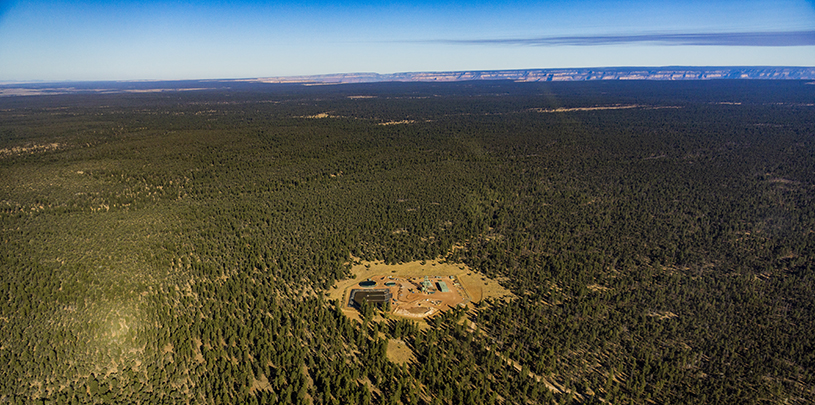
by Amber Reimondo, Energy Director
Canyon Mine, which has yet to extract uranium ore after three decades despite a contested exemption from the current mining ban, is already an environmental blight near the Grand Canyon.
The mine, despite being what some describe as a “modern” mining operation — one that operates in the era of environmental regulations — is a clear example of why uranium mining is a dangerous and unsustainable activity for the Grand Canyon region and the people, economies, and wildlife the Grand Canyon supports. The mine’s sordid environmental track record is the topic of a new research report published by the Grand Canyon Trust: “Canyon Mine: Why No Uranium Mine is ‘Safe’ for the Grand Canyon Region.”
The Grand Canyon region is the physical and spiritual home of several Native American tribes. It’s the hub of northern Arizona’s tourism and outdoor-recreation-based economy, and the source of water for millions.

The complexity and vast unknowns about the region’s groundwater flow make it virtually impossible to definitively assess and manage risk as well as any contamination that occurs. It’s because of this combination of high risks and high unknowns that the current temporary Grand Canyon mining ban was put in place in 2012. The new report summarizes problems at Canyon Mine, which demonstrate precisely why uranium mining should not be allowed in such a critical, yet insufficiently understood region.
Without a clear understanding of groundwater flow, adequate groundwater monitoring is more important than ever. Yet groundwater monitoring at Canyon Mine is substandard, in part because of the type of groundwater permit the mine has been given.
In order to operate, Canyon Mine is required by the Arizona Department of Environmental Quality (ADEQ) to have an aquifer protection permit. From the early 1990s until 2008, ADEQ required the mine to apply for a more stringent “individual” aquifer protection permit, which assumes the mine has the potential to contaminate groundwater and can be accompanied by site-specific requirements like additional monitoring wells. But records show the mine was unable to gain approval for an individual permit due, in part, to “deficiencies” in the mine’s 1993 application.
In 2008, as the mine owner worked to bring the mine out of a nearly two-decade standby period, the company instead applied for, and was denied, a “general” permit — a much more lenient permit that involves “voluntary conditions,” no public comment periods, and helps ADEQ to “save a lot of staff time.”
In the 2008 general permit denial, ADEQ informed the mine owner that the “facility does not conform to the requirements of the general permit” and that it needed to apply for an individual permit. But abruptly, in 2009, shortly into Arizona Governor Jan Brewer’s new administration, the mine owner again applied for a general permit and was ultimately approved. Canyon Mine’s owners applied to renew its general permit last summer. ADEQ still has not announced a decision, but is expected to do so soon.
Take Action. Urge ADEQ to require a more stringent, "individual" permit for Canyon Mine ›

When Canyon Mine was first being permitted in the late 1980s, the mine’s owners assured regulators that it posed little danger to groundwater, in large part because its mine shaft would be dry. But as miners were constructing the 1,470-foot-deep mine shaft in 2016, the mine began taking on significant quantities of water — over 30 million gallons to date —contaminated with levels of uranium and arsenic several times the Environmental Protection Agency’s safe drinking water standards.
If contaminated water at any point, perhaps even long after the mine is closed, finds its way into groundwater, the results could be devastating, particularly for the Havasupai Tribe. On the Havasupai reservation, in a side canyon off the Grand Canyon, Havasu Creek flows through Supai Village from the Redwall-Muav Aquifer, a regional aquifer that underlies Canyon Mine. The creek feeds the iconic blue-green waterfalls that draw tourists from around the globe and are the main driver of the tribe’s economy.

The report explains other issues as well, including failures to maintain flood control infrastructure, the company’s struggle to manage the influx of water into the mine shaft, and the deliberate use of the contaminated mine-shaft water for onsite dust suppression as a way of “managing” the mine's flooding problem.
Canyon Mine serves as a clear warning of what can happen when the realities of mining in the Grand Canyon region are ignored. In general, mines destabilize uranium ore by exposing it to the elements, triggering millions of years of struggle with Mother Nature to keep it contained and out of the air we breathe and the water we drink. This destabilization is especially risky near the Grand Canyon, where groundwater pathways are unclear. Canyon Mine’s ongoing flooding underscores that reality.
Canyon Mine also underscores another reality: that of a private company’s ultimate concern for its own bottom line. This self-interest is a dangerous incentive for mining companies to seek pathways toward more lenient, less expensive oversight.
Take action. Urge Arizona regulators to close and clean up Canyon Mine.
A small victory in the legal case challenging Daneros uranium mine, near Bears Ears National Monument.
Read MoreGroundwater pumping at a uranium mine near the Grand Canyon will affect the canyon's springs, scientists says.
Read MoreA rally in Salt Lake City followed by a spiritual walk in White Mesa demonstrate the Ute community's determination to see uranium mill close.
Read More